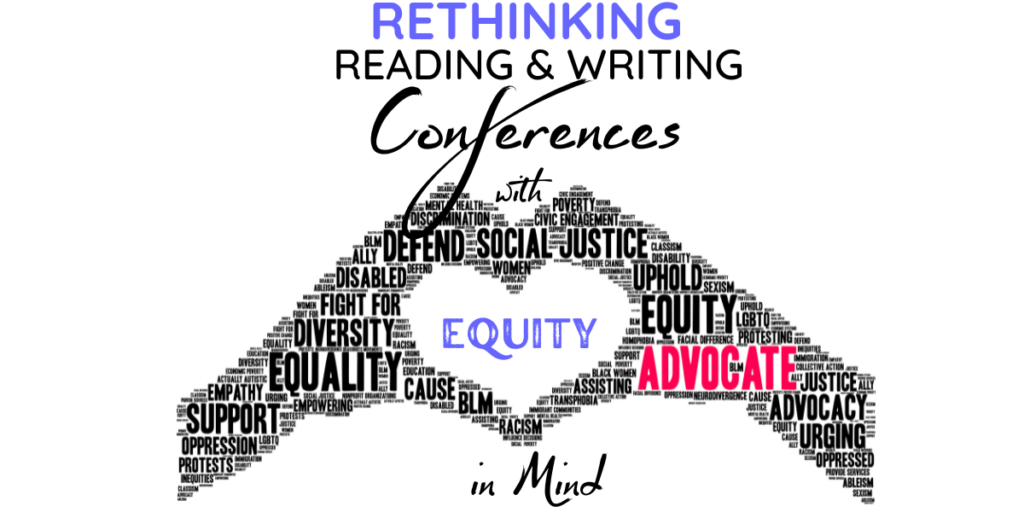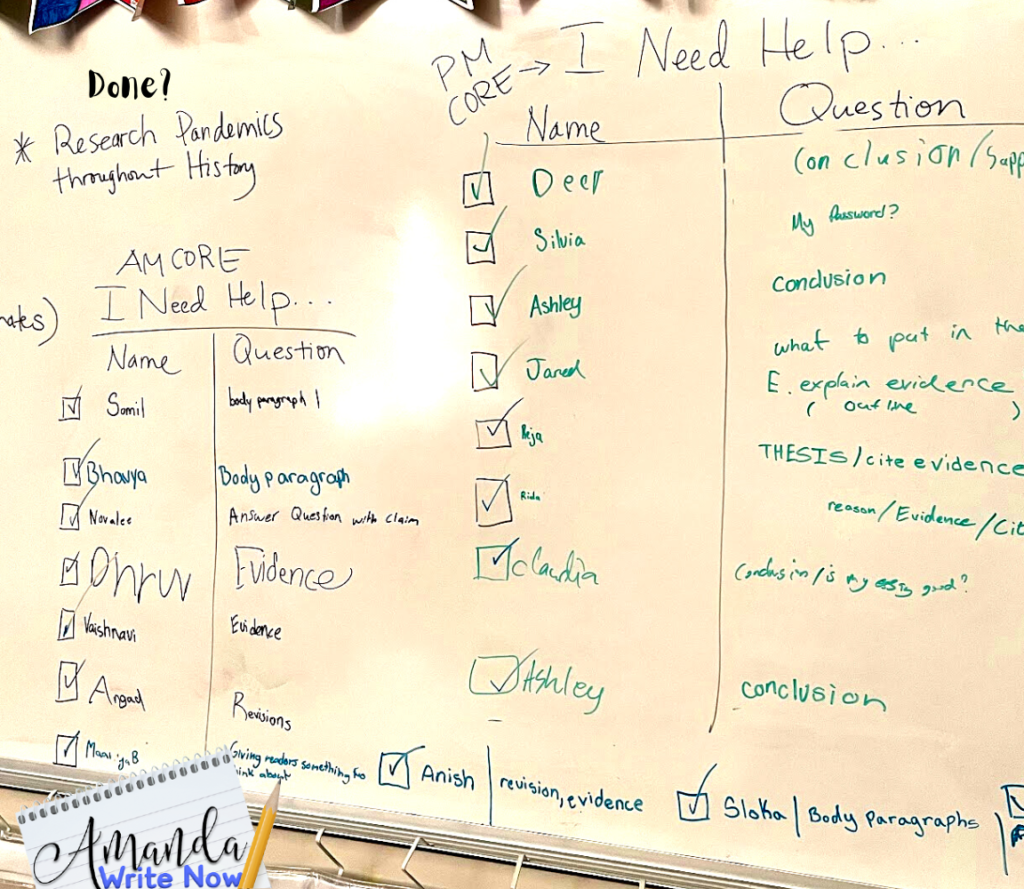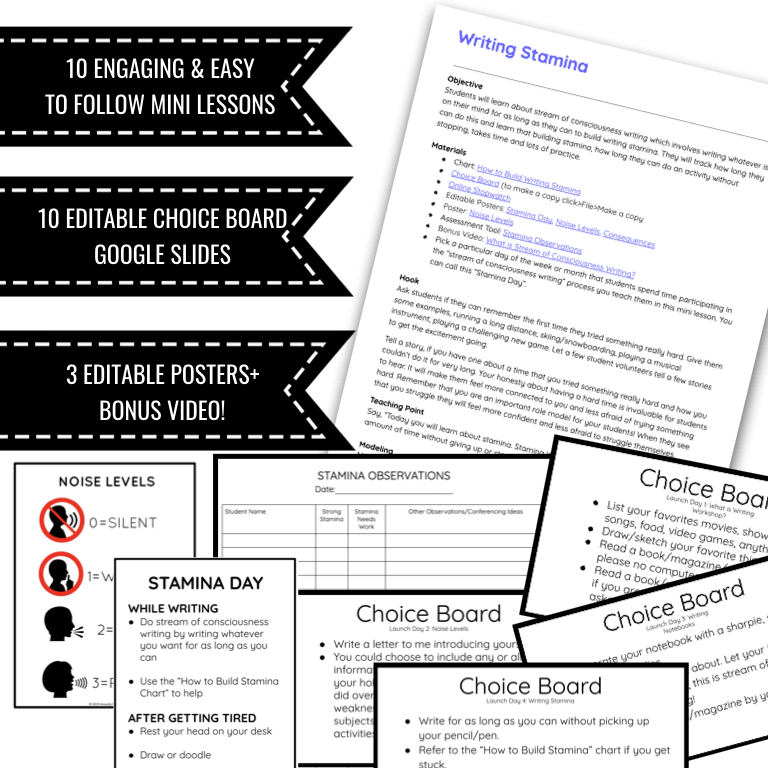
In this six part series I will outline exactly how I’m rethinking conferencing with an equity lens.
Check out part 1 about rethinking writing workshop here.
Check out part 2 about rethinking reading workshop here.
Before getting started, we need to define workshop, conferencing, and equity. Here is my very brief definition of all three…
Workshop– a method of teaching that empowers students to become readers and writers in and outside of the classroom. This method of teaching involves a system wherein students work toward publishing pieces of writing and developing identities as readers by choosing the books they are interested in. Workshop also prioritizes developing a supportive community of readers and writers.
Conferencing- meeting one-on-one or in small groups to support students with their work.
Equity-the act of treating people fairly. This is not to be confused with equality which is treating people equally. Our students are all unique and have different needs, so treating them all equally is just not possible, but treating them fairly and with their individual needs in mind is possible.
The Research on Conferring
When a teacher Googles, “Conferencing with students”, they will quickly find that virtually every website, from ASCD to Two Writing Teachers to Edutopia, tout the benefits of conferencing with students.
It’s not hard to find information and research about how important and impactful it is to conference with students. You can find blog posts on my website about how to implement conferencing and the benefits of doing so. I also found this handy checklist of equitable teaching practices here, guess what the 27th item is?
“The teacher provides individual help to all students”.
We know conferring is a vital component of promoting equity in our classroom because doing so provides students with opportunities to advocate for themselves, voice their needs, and get support from the teacher.
We know conferencing is important.
But, how do we overcome all the problematic issues we as teachers face when trying to conference with our students? What about the challenges of conferencing that everyday teachers face? What is a teacher to do when it just doesn’t seem to work the way all the workshop gurus say it will? And most important of all…how can we use conferencing practices successfully, to promote equity in our classrooms?
The fact is, for a regular teacher in the trenches, conferencing is, to state plainly, tough. And I’ll go even further…it’s unrealistic.
In the previous blog posts I discussed three problems with reading workshop, three problems with writing workshop, and proposed solutions for these problems.
In this blog post, I discuss one big problem that is at the root of a lot of little problems when it comes to conferring. This overarching problem is the cause of many other problems: off-task students, the inability to track what happens in conferences, not being able to facilitate follow-up conferences, teacher overwhelm, student overwhelm, and a general lack of classroom cohesion.
So what is this one big problem? I bet you can guess it…
The One Big Problem
There’s 1 adult and 30+ students.
This is a huge hurdle when it comes to trying to conference with students.
Let’s do a little math, say you spend 5 minutes with each student. This would take a total of 150 minutes of class time. If a teacher has a 52-minute period, this would require three entire class periods. But, most teachers don’t conference the entire class period. When I run professional development webinars, I tell teachers to dedicate 20 minutes to “work time” where students are reading and writing independently and the teacher is freed up to conference. If a teacher were to take this advice, it would take 7. 5 twenty-minute class periods to meet with everyone. This sounds doable, right? A week and a half, done meeting with each student, win!
Wrong.
When a teacher implements conferences, there is almost always off-task behavior to contend with. In addition, there may be students who need immediate help, but who weren’t on the list of students the teacher planned to meet with that day. And then, what about follow-up conferences with students who may need it? The fact is that things can get hairy fast. Now, let’s get to the good news, there are some possible solutions…
A Step-by-Step Solution
The truth is that the traditional way of conferencing with students is through an equality lens. We feel we should spend an equal amount of time with each of our students. And we know, equity is all about fairness, not obtaining equal amounts of time with the teacher.
So, I propose a more equity-focused conferencing classroom. Here’s the step-by-step process to make this work in your classroom.
1. Only conference when you feel your class is ready.
Many teachers dive into conferring when students just aren’t ready to work independently yet. This can cause many problems and a lot of stress for both the teacher and students. We need to test the waters of independent work time first.
When you are ready to launch reading and writing workshop tell students that you want to assess their independent work time abilities first. Explain, that you will set a timer for 5 minutes on the first day (make it visible to students too) and document how they do.
Track which students struggle to work independently and which are capable of independent work. You can access a tracker template in the resource below. See step two for the students who struggle. See step three for the rest. The next day, increase the timer to ten minutes.
If you notice most of your students aren’t able to work independently, then I would not recommend conferencing. Instead, realize that your students need you to monitor their behavior by wandering the room and observing them as they work. You can’t conference if students can’t work independently, you just can’t. Until then, put off conferencing.
The unit below can help you launch reading and writing workshop in a way that increases student independence, so you can conference eventually…
This Launching Reading and Writing Workshop Unit helps teachers do the following:
- Assess students’ writing and reading stamina to determine the next steps for the class when it comes to independent work time.
- Build a “stamina day” routine into their weekly/monthly schedule so students can develop their independence as readers and writers.
- Develop noise level expectations.
- Teach students about the workshop framework.
- Teach students how to work with writing partners.
- Teach students personalized note-taking methods.
- Help students develop life-long habits as readers and writers.
2. Conference with students who need extra support, every day.
Every classroom has at least five students who need a lot of extra support with reading and writing. These student could be the students with IEPs/504s, but they could also be students who don’t have formal accommodation plans, yet. You could choose to meet with a couple of these students at a time, to give them a plan of action for the day. You might provide a graphic organizer, sentence stems or an alternative work plan such as listening to an audio book, or making their argumentative writing piece out of loose parts from the classroom. These students are usually the ones who do very little on their own, and may even distract others because they need your extra support.
3. Allow students to self-identify when they need a conference.
Students who are not part of the extra support group, need opportunities to conference with you too. But, may not need conferences every day. For these students, I recommend having a sign up sheet available to them. When they are ready for a conference with you, they put their name on the signup sheet and list the exact thing they would like to talk about, or need feedback on. I urge students to use language from the rubric when writing what they need support with. After meeting with “the regulars”, you can visit this list to see which students need help.

4. Use a simple tracking tool to identify students who fly under the radar.
When you meet with certain students every day and you help students who ask for it, you might overlook another group of students, the ones who fly under the radar. These students are most likely very self-sufficient and most likely shy. This is why tracking is important. Everytime you meet with a student put a check mark next to their name (even the students you meet with every day). This way you have documentation that points you toward these student who may not always need help, but who deserve your attention and support too.
5. Scan student work and determine next steps.
At the end of your unit, there may be certain students you didn’t get to conference with. I recommend scanning their work and determining what support you might provide them the next day or in a comment on a Google Doc. Don’t fret if you didn’t conference with everyone. Remember, we are conferring with an equity focus, and that means some students may need more support from you and others may need less. Use a combination of your tracking tool and a quick scan of student work, to determine where the holes are and take action from there.
Wrap Up
Each student is unique and has different needs. Some students need more support than others. We can’t deny this fact. We do students (and ourselves) a disservice when we try to give each student an equal amount of our time. This approach just causes headaches and ignores the elephant in the room, that our students have diverse needs. Instead, recognize that in order to promote equity (fairness) through our conferring techniques, we will have to adjust our thinking and classroom routines. Some students need daily conferences, others may just need one, and some students might just need a bit of support through a comment thread in a Google Doc. When we can work towards more flexibility and adaptability in our conferring techniques, students get what they uniquely need, and our stress and overwhelm can potentially be lowered as well!


0 Comments